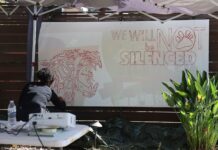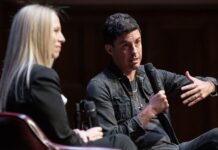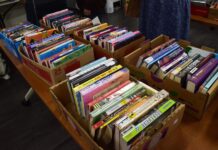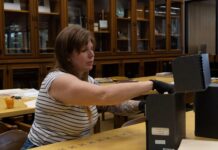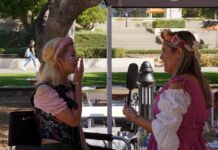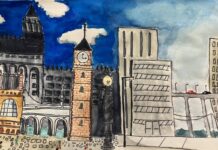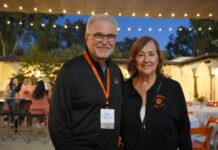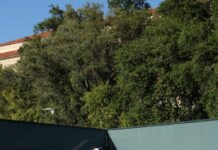
The reception for Oxy Arts Initiate! honored eight students and their three projects covering topics from running to fashion to transnational blackness, Nov. 15. Initiate! offers students the opportunity to create and curate an interdisciplinary arts event, workshop or project on campus, according to the Oxy Arts website.
Danika Odell (junior), Thomas Robertson (junior) and Jackie Dall’s (sophomore)* exhibition is titled “(When We) Can’t Run Away,” and it explores running as political action and its relationship with the environment.
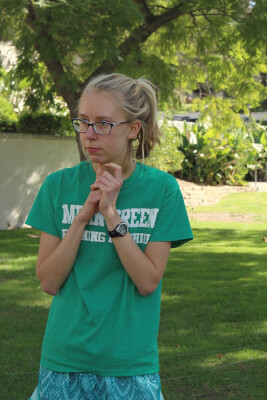
“All three of us that are in this project are runners,” Robertson said. “We’re very familiar with our type of running — running on a trail — but we were meditating on other forms of running, whether it be running away as a refugee or even just the movement of bodies.”
The idea developed through a late night conversation between the three about an article on running in Burundi.
“I saw an article about how in the country Burundi, there was a ban on group running because group running was a means of political socialization and [forming] anti-government groups,” Robertson said. “It was the first transition from thinking of the way we conceive running, the sport, and how it’s so much more than that.”
The group created an interactive labyrinth using string lights and clay pots made by Odell. It is modeled after running routes of LA. The labyrinth lit the reception entrance at 5 p.m. Nov. 15, covering the lawn in front of Weingart.
“We’ve been thinking about how we use space to control that movement and how moving through those places affects your experience of it,” Odell said. “This is a labyrinth, but in a way, it represents other physical spaces in the LA area.”
While the creators of “(When We) Can’t Run Away” were influenced by their experiences of running in LA, artists Sam Peck-Sanders (junior), Kendrick Shoji (junior) and Julian Strauss (sophomore) looked to New York for inspiration for their exhibition, a city where all three are from. Their exhibit is titled, “Ad(dressing) the Self; Consuming Meta-Goods through Fashion.”
The exhibition room displayed sculptures, as well as video and photographs arranged in neat rows plastered the walls. According to Shoji, the overwhelming nature of the photographs on the walls was influenced by the billboards in New York.
“Drawing upon notions of the indeterminate self, this collaboration will satirically deploy aesthetic advertisement as solutions for the fragmented human condition,” the exhibition description read.
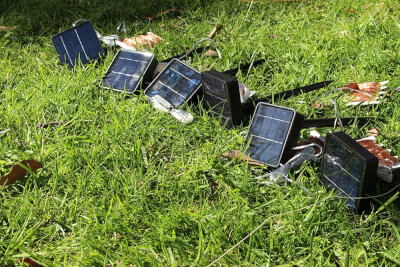
According to Peck-Sanders, the idea for the exhibition came from a class conversation about how art can either be problematic or problem-solving. Shoji said it is also a reflection on materialism and selfhood.
“Each piece of clothing is kind of selling an identity and an idea that you can embody,” Shoji said.
The third exhibition was “Ririkana Omoide,” by Tia Fujino Reid (senior) and Waruguru Waithira (senior). The two roommates collected oral histories in Japan and Kenya, respectively, over the summer and applied for Initiate! as a way to share their work.
Reid went to Japan and collected 17 oral histories of black Japanese individuals to learn about their unique experiences. Reid grew up in the United States and identifies as black Japanese.
“I was conducting the interviews for the oral histories and they would say something and it would catch me off guard. I would feel surprised or feel something — either hurt or happiness,” Reid said. “It was something that I really felt … when I heard it, I said, ‘People need to hear this.’”
Waruguru’s project was inspired by her 104-year-old great-grandmother who was a member of the militia that drove the British out of Kenya and was tortured during the British colonial administration.
“She inspired me to go out there and interview all these women and get their stories before they pass away,” Waithira said.
Both Reid and Waithira collected oral histories but with different methods. Reid solely used audio, whereas Waithira used the visual form of a documentary. They both mention encountering a debate over whether oral history is an academic form.
“Some things that come up with oral history and people sharing their stories is, ‘They’re old,’ or ‘It’s going to be biased, so it’s not true; if it’s not in the history books it’s not true at all,’” Reid said. “It was really amazing just going against that and challenging that, saying that these are their experiences and they are real.”
Their title, “Ririkana Omoide,” joins the Gíkúyú word for remember, “Ririkana,” with the Japanese word for memories, “Omoide.” Their title is not the only aspect of the work that is not translated.
“Parts of our history that we collected, some of it we didn’t translate. That’s a way of challenging the Western way of learning because why does everything have to be in English?” Waithira Waruguru said. “Part of the film is translated, but [not] when my grandmother is singing and telling a story about colonization.”
Overall, the exhibition presents nuanced experiences and highlights the multiplicity within blackness.
“With watching Waruguru’s film, there’s moments of discussing these horrible things that have happened and then there’s moments of happiness, of cooking, of laughter. It’s not just black and white. It’s all in-between,” Reid said.
“I hope that people, after seeing the exhibition, will have an understanding that this is what blackness is outside of America. It’s not like this everywhere, and we can’t put it in a box and say that this is what it’s like everywhere. People have very different experiences,” Waithira said.
The exhibitions were on view Nov. 15–23.
*Jackie Dall is the communications director of The Occidental.
![]()


